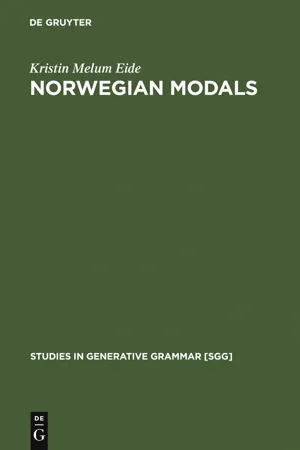Norwegian Modals
About this book
Norwegian Modals is a detailed description of the syntactic and semantic properties of modals in Norwegian. Modal verbs in Mainland Scandinavian languages have received much less attention than their English and German counterparts, hence this book seizes the opportunity to present a range of new data and generalizations relevant for the study of Scandinavian languages, but also for the study of modality in Germanic and other languages. The book critically evaluates a range of proposals from the modality literature, focusing on the Theta-properties and the scopal properties of Modals in Germanic languages, and concludes that none of these previous proposals are able to account for the syntax of modals in Norwegian. The Theta-properties of modals are shown to depend on the construction in which the modal occurs, hence neither a raising analysis, a control analysis, nor a raising-versus-control analysis in fact suffices to exhaust these properties of Norwegian modals. The interplay of modals with tense and aspect is likewise thoroughly investigated, presenting a range of data revealing that existing universalist proposals are insufficient to account for even quite regular patterns. Instead, a new analysis is presented, building on a new compositional tense system which exploits aspectual features of predicates and selectional preferences of modal classes.
Frequently asked questions
- Essential is ideal for learners and professionals who enjoy exploring a wide range of subjects. Access the Essential Library with 800,000+ trusted titles and best-sellers across business, personal growth, and the humanities. Includes unlimited reading time and Standard Read Aloud voice.
- Complete: Perfect for advanced learners and researchers needing full, unrestricted access. Unlock 1.4M+ books across hundreds of subjects, including academic and specialized titles. The Complete Plan also includes advanced features like Premium Read Aloud and Research Assistant.
Please note we cannot support devices running on iOS 13 and Android 7 or earlier. Learn more about using the app.
Information
Table of contents
- Chapter 1: Introduction
- 1. Norwegian modals: main verbs and auxiliaries
- 2. The central subjects of this investigation
- 3. The root-epistemic distinction
- 4. The framework
- 5. The data
- Chapter 2: Norwegian Modals: the Facts
- 1. Introduction
- 2. Morphological characteristics
- 3. Semantic characteristics
- 3.1 A brief overview of some central modality terms
- 3.2 Two seminal formal semantic descriptions of modals
- 3.3 A semantic field of modality
- 3.4 The semantic properties of Norwegain modals
- 3.5 Modals, readings and n-place relations
- 4. Syntactic characteristics
- 4.1 Complements of Norwegian modals
- 4.2 Modals, ellipsis, and tags
- 4.3 Summary of findings
- 5. Summary and preliminary inventory
- 5.1. Examining our results
- 6. Three potential candidates
- 7 Final inventory and inventories of seven other languages
- 7.1 Norwegian modals: final inventory
- 7.2 Inventories of modals in seven other languages
- Chapter 3: Analyzing Modals: a Survey of Recent Proposals
- 1. Two central notions
- 1.1. Theta-roles
- 1.2. Functional projections
- 2. Some earlier proposals
- 2.1. Roberts (1985)
- 2.2. Roberts (1993)
- 2.3. Roberts and Roussou (2002, 2003)
- 2.4. Cinque (1999)
- 2.5. Vikner(1988)
- 2.6. Thráinsson and Vikner (1995)
- 2.7. Barbiers (1995, 2002)
- 2.8. Lødrup (1996a)
- 2.9. Dyvik(1999)
- 2.10. Wurmbrand (1999, 2001)
- 2.11. Butler (2003)
- 2.12. van Gelderen (2003, 2004)
- 2.13. Picallo(1990)
- 3. Modals and theta-roles
- 4. Insertion or merger point of root and non-root modals
- Chapter 4: Norwegian Modals: Argument Structure
- 1. Introduction
- 2. The control versus raising analysis
- 3. Modals in pseudoclefts
- 3.1 The relevant generalization: ± proposition scope
- 3.2 The pseudocleft construction
- 3.3 Modals and subject scope
- 3.4 Competing for subject positions: Theta relations vs. subject scope
- 3.5 Subject-orientedness and subject positions
- 3.6 Reanalysis verbs
- 3.7 Raising verbs and pseudoclefts
- 4. Explaining subject-orientedness
- 4.1. It is not a real Theta-role
- 4.2 Occational redefinition of argument structure
- 4.3 Double entries
- 4.4 Optional Theta-assignment
- 4.5 Evaluating the alternatives
- 5. The source of modality: Two semantic levels
- 6. Summary
- Chapter 5: Norwegian Modals, Aspect and Tense
- 1. Introduction
- 2. Tense and aspect
- 2.1 Tense
- 2.2 Aspect
- 3. Aspect and tense of complements
- 3.1 Directional small clauses
- 3.2 The perfect
- 3.3 The progressive
- 3.4 The iterative
- 4. Modality, tense, and aspect: Scope, readings, and universality
- 4.1. Creole TMA systems and universalist hyotheses
- 4.2. TMA markers in Norwegian
- 4.3 Modal-aspectual sequences in other languages
- 4.4 Universalist approaches and the modal-tense-aspectual data
- 5. A compositional tense system for Norwegian
- 5.1 Julien (2000a, 2001)
- 5.2 A different approach
- 5.3 The function of ha ‚have‘
- 6. The properties of the complement: tense and aspect
- 6.1 Default and overrride
- 6.2 Truth values and tenses, verbs and directionals
- 7. The tense properties of root and non-root modals
- 7.1 The tense of root modals
- 7.2 The tense of non-root modals
- 8. Summing up
- Chapter 6: Summing up
- 1. Introduction
- 2. The facts
- 3. Earlier proposals
- 4. Argument structure
- 5. Modals, aspect, and tense
- 6. Concluding remarks
- References
- Index
